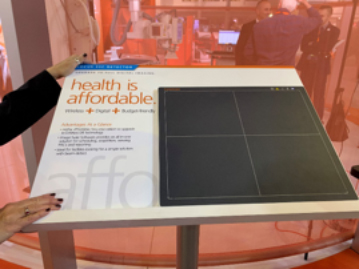Carestream demonstrates technologies designed to improve workflow and enable better diagnosis
Carestream is displaying its new Focus 35C Detector with Image Suite Software, which offers healthcare providers a cost-effective way to tap into the power of digital medical imaging. It’s expected to be commercially available later this year.

The Focus 35C Detector with Image Suite Software offers a smaller
cost-effective way to tap into the power of digital medical imaging
The highly economical solution is powered by Carestream’s Eclipse image processing engine and combines advanced image processing with broad functionality, easily transforming an analog X-ray room into a full wireless digital radiography (DR) system.
“It’s a great way for smaller facilities to jump into DR imaging and get wireless technology at an affordable price,” said Jill Hamman, Worldwide Marketing Manager for Global X-ray Solutions at Carestream. “Now clinicians at these facilities can get an image and preview it all in one visit on the same equipment they already have.”
The company also introduced a three-dimensional extension of general radiography through its Digital Tomosynthesis (DT) functionality (pending FDA 510(k) clearance). Simplifying workflow and reducing exam time, Carestream’s DT technology is an upgradable option on the DRX-Evolution Plus System. This DT technique uses a single sweep of X-ray exposures and simplifies the operator’s workflow by separating the process of DT exposure acquisition from image volume formation. As a result, multiple projections are acquired during a single DT acquisition sweep.
“This exam takes images in rapid succession, making it just as quick as taking a standard X-ray,” said Sarah Verna, Worldwide Marketing Manager for Global X-ray Solutions at Carestream. “It allows doctors to scroll through slices and identify anything of concern or track treatment progress.”
This functionality will roll out with Carestream’s Dual-Energy technology, which utilizes two filter materials that enable automatic switching between the high- and low-energy exposures to produce a soft-tissue-only image with the bone structures removed, as well as a corresponding bone-only image. Both product offerings are expected to be released early next year.
